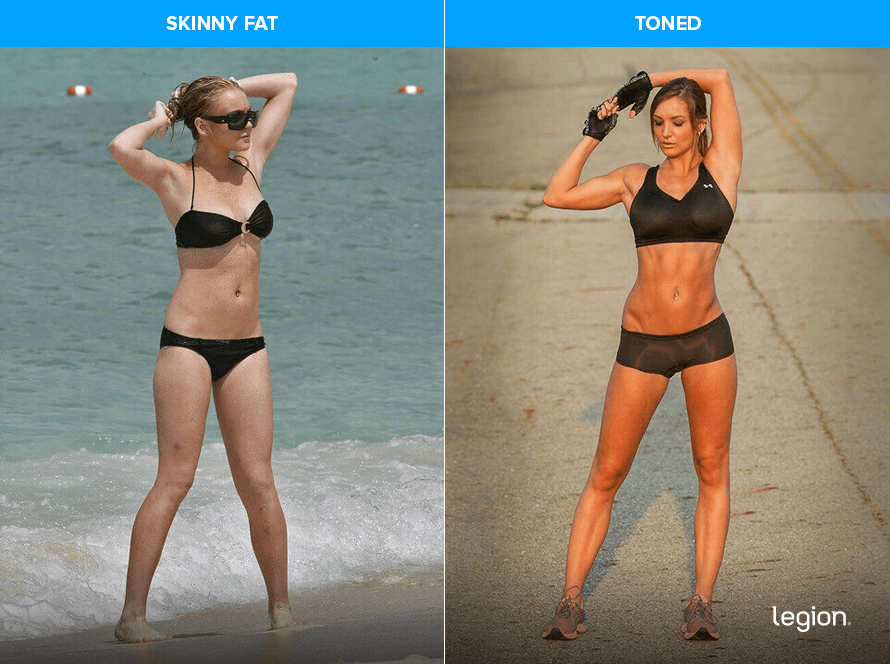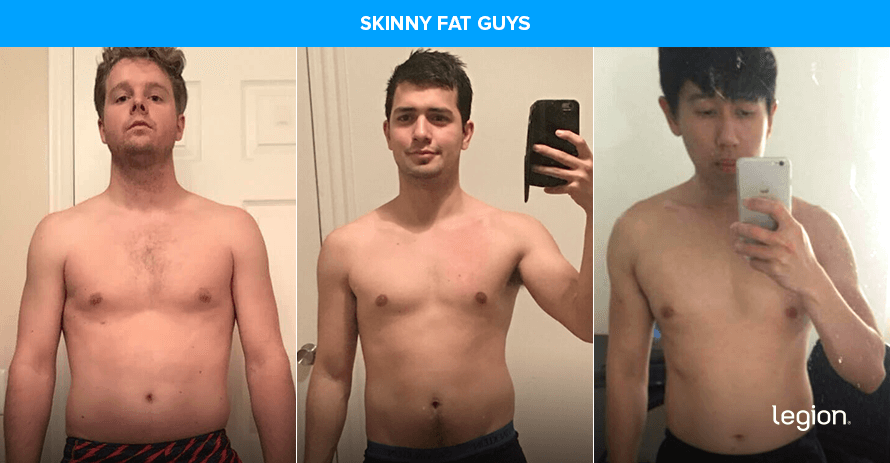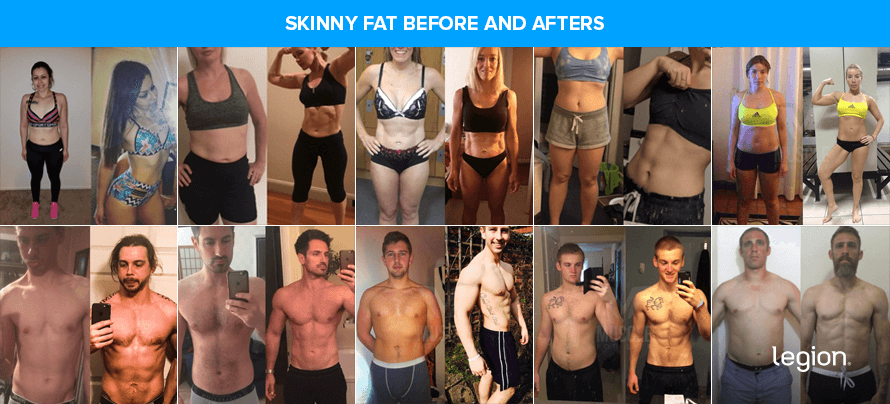Learn what causes “skinny fatness” and how to fix it.
The post Why People Are Skinny Fat (and How to Fix It) appeared first on Legion Athletics.
If you think you might be skinny fat and you want to know how to get rid of skinny fatness, you’re in the right place.
First, what is skinny fat?
“Skinny fat” simply describes a state in which someone has too little muscle mass and too much body fat.
People who are skinny fat often look normal or even skinny when wearing clothes, but look soft, weak, and flabby underneath. Hence the name, “skinny fat.”
Skinny fatness can even afflict people who think they’re doing everything right with their diet and workouts. You’ve probably seen or experienced this yourself: you go to the gym regularly, you do cardio every week, you eat “clean,” and you still look skinny fat.
So, what causes skinny fatness and how can you get rid of it?
The long story short is that you become skinny fat by making a handful of simple diet and training mistakes. Namely, severely restricting your calories, undereating protein, not lifting weights or not lifting weights properly, or doing too much cardio.
And the solution is as simple as correcting these blunders, which is what you’ll learn how to do in this article.
[h=2]What Is Skinny Fat?[/h]“Skinny fat” describes a condition where someone at a relatively normal body weight has too little muscle and too much body fat, giving them a shapeless, undefined look.
In other words, how skinny fat you are boils down to your body composition. That is, how much of your weight is either fat or muscle.
Even if you’re at a relatively healthy weight or BMI, it’s possible to have a skinny fat physique.
If someone is at a healthy weight, their problem isn’t generally that they have too much body fat. Instead, it’s that they have too little muscle.
This is particularly hard for many women to wrap their heads around, as they tend to be more concerned with losing fat (and reaching or maintaining a specific weight) than building muscle.
While losing weight can be helpful for improving your physique, it’s not as important as optimizing your body composition.
For example, check out the following two pictures:

Both of these women are more or less at the same body fat percentage!
Although the woman on the right is slightly leaner, the major difference between their physiques is the amount of muscle they’re carrying. The woman on the left has little and the one on the right has quite a bit.
This image illustrates an important point: The less muscle you have, the more prone you are to look skinny fat despite being at a healthy weight. An extremely under-muscled guy at 15% body fat can look skinny fat whereas a muscle-bound guy at the same level of body fat can look impressive.
[h=2]Want to save 20% on your first order of Legion supplements?[/h] Sending...
Success! Your coupon is on the way. Keep an eye on that inbox!
Looks like you're already subscribed!
[h=2]Skinny Fat Examples[/h]What does skinny fat look like, you wonder? Here are some skinny fat examples:


As you can see, these people don’t look unhealthy, but they don’t really look “fit,” either.
[h=2]Why Am I Skinny Fat?[/h]The four main reasons people become skinny fat are that they . . .
Simply put, heavy, compound weightlifting is your golden ticket to fixing skinny fatness. You can make every other mistake on this list, but if you also do lots of heavy weightlifting, you’ll still build muscle and be less skinny fat than you would otherwise.
You don’t have to do much to reap the benefits, either: just two or three weightlifting workouts per week is enough to see noticeable improvements, and four or five workouts per week is about the maximum you’d ever need to do.
[h=3]Eating Too Little Protein[/h]Eating too little protein deprives your body of the raw material it needs to build muscle, and thus makes it nearly impossible to gain muscle and strength. To make matters worse, eating too little protein also makes it harder to stay full after meals, increasing your chances of overeating and making fat loss more difficult.
A good rule of thumb is that you generally want to eat 0.8 to 1 gram of protein per pound of body weight per day, which works out to around 30 to 40% of your calories for most people.
[h=3]Severe Calorie Restriction[/h]Severe calorie restriction can result in rapid muscle loss, especially when you aren’t lifting weights, which promotes skinny fatness.
This is why I recommend a moderate calorie deficit of about 20 to 25% when losing fat. Research shows that, when combined with a strength training program and a high-protein diet, this deficit allows for rapid fat loss while also preserving muscle.
[h=3]Excessive Cardio[/h]While doing cardio can help you stay healthy and lean, excessive amounts of cardio contribute to skinny fatness by interfering with your ability to gain strength and muscle. When combined with a very low-calorie, low-protein diet, lots of cardio can also speed up muscle loss even further.
Thus, you want to do a moderate amount of cardio to stay healthy and lean, but not so much that it interferes with your weightlifting workouts.
[h=2]How to Get Rid of Skinny Fat[/h]There are two ways to tackle skinny fatness: losing fat and building muscle. In other words, “cutting” and “lean bulking.” As I mentioned previously, most people who are skinny fat would be better served by building muscle before losing fat, as this will make the biggest impact on their appearance and health.
Then, once you’ve built some muscle, focus on losing your excess body fat for a few months, and you’ll start seeing drastic improvements in your appearance.
The one exception to this rule is if you’re brand new to proper weightlifting, in which case you can gain muscle and lose fat at the same time. In this case, you should focus on losing fat first, as you’ll still be able to build a respectable amount of muscle as you go along.
Regardless of whether you cut or lean bulk first, here’s how to do it:
[h=3]Do a lot of heavy compound weightlifting.[/h]When you want to maximize muscle growth, you have to emphasize heavy, compound weightlifting in your workouts. High-rep “pump” workouts that emphasize isolation exercises are far less effective for muscle building and quickly stop working for most people.
Instead of chasing a pump or seeing how many TRX push-ups you can do, your primary goal is to get very strong on exercises like the squat, deadlift, bench press, and military press. Most people see the best results when they can do these kinds of workouts three to five times per week.
What’s more, you should also strive to add weight or reps to every exercise in every workout. This is known as progressive overload, and it’s essential that you do it if you want to banish skinny fatness for good.
Read this article to find a strength training program that will help you stop being skinny fat:
The 12 Best Science-Based Strength Training Programs for Gaining Muscle and Strength
[h=3]Do a moderate amount of cardio.[/h]The best way to include cardio in a weight loss regimen is to do as little as needed to reach your desired rate of weight loss and stay fit, and no more.
Here’s what typically works best:
The good news, though, is that dieting isn’t nearly as complicated or grueling as most “gurus” would have you believe.
To lose fat, maintain a moderate calorie deficit.
As I mentioned earlier, crash dieting is one of the most reliable ways to burn away your hard-earned muscle—especially when combined with a low-protein diet, a bunch of cardio, and high-rep, low-weight resistance training (or none at all).
Instead, first use the Legion Total Daily Energy Expenditure (TDEE) calculator to estimate how many calories you need to eat to maintain your weight every day. Then, subtract 20% from this number, and aim to eat this many calories every day.
To build muscle, maintain a small calorie surplus.
Building muscle is an energy-intensive process, and it won’t occur as quickly as it should if you’re eating just enough to maintain your weight or are restricting your calories.
Fortunately, a slight calorie surplus of just 5 to 10% is enough to maximize muscle growth without producing too much unwanted fat gain. That is, if you eat 5 to 10% more calories than you burn every day, you’ll grease the skids of your body’s “muscle-building machinery” and markedly enhance your results.
You know you’ve got it right when you’re gaining 1 to 3 pounds per month if you’re a man, and about half that if you’re a woman, unless you’re new to weightlifting, in which case you can double those numbers for your first three to six months.
After that, however, you should see your weight gain settle into this range.
The process for estimating how many calories you should eat to build muscle is the same as for figuring out your cutting calories: estimate your TDEE, then add 5 to 10% to this number (I recommend you start with 10% and then reduce your calorie intake if you find you’re gaining weight too quickly).
Finally, remember to eat at least 0.8 to 1 gram of protein per day, regardless of whether you’re cutting or lean bulking.
If you’d like to learn more about how proper dieting and how to turn these tips into a meal plan for losing fat or building muscle, check out this article:
The Definitive Guide to Effective Meal Planning
[h=2]Is Being Skinny Fat Unhealthy?[/h]Someone who’s skinny fat isn’t necessarily unhealthy, but they’ll probably be healthier and reduce their risk of various diseases by losing fat and building muscle.
Although many people think they’re healthy if they aren’t overweight according to a BMI chart, this doesn’t tell the whole story.
It’s possible to be a normal weight and have a healthy BMI with an unhealthy level of body fat. In fact, research shows people can be metabolically obese at a normal body weight, meaning they aren’t overweight by medical standards but still suffer from some of the same metabolic complications as their obese counterparts, like insulin resistance, high cholesterol and trigylyceride levels, and high blood pressure. This is particularly true if these people are carrying large amounts of visceral fat, which is associated with many diseases and an early death.
And in many cases, these people are also skinny fat.
Now, not all skinny fat people have metabolic abnormalities, but it’s fair to say that maintaining a healthy body fat percentage is a good way to lower your risk of these conditions.
What many people don’t know, though, is that building and maintaining muscle may be just as important to your health and longevity as losing fat and staying lean.
For example, a study conducted by scientists at the University of California found that people with high levels of body fat and lean mass were less likely to die of heart disease than people with low levels of body fat and little muscle mass.
In other words, people with a lot of muscle and some extra body fat were less likely to die than their skinny-fat counterparts.
Other studies conducted at the University of Adger, Geneva University, Kaiser Permanente, and the David Geffen School of Medicine have found that people with more muscle mass have a lower risk of diabetes and cancer and a generally higher quality of life.
[h=2]10 Impressive Skinny Fat Transformations[/h]If you’ve been skinny fat for a while, chances are good you’ve tried other methods to fix it. And since you’re reading this, chances are good they didn’t work.
So, if you’re skeptical, I understand.
If you follow the advice in this article, though, you will not be skinny fat in three to six months (depending on how skinny fat you are).
If you want some “skinny fat to fit” inspiration before implementing the advice in this article, check out these skinny fat before and afters from people that have done my Bigger Leaner Stronger and Thinner Leaner Stronger programs:

[h=2]FAQ #1: How can I tell if I’m skinny fat?[/h]There isn’t a precise definition of what qualifies as “skinny fat.”
Unless you’re a metabolically obese, normal-weight person, it’s primarily a subjective determination based on how you look.
That said, a good rule of thumb is if you’re a guy somewhere between 10% and 20% body fat or a woman between 20% and 30% body fat, you’re not naturally muscular, and you haven’t done any strength training in the past year or so (or ever), you’re probably skinny fat.
[h=2]FAQ #2: How long does it take to go from skinny fat to fit?[/h]This depends on how skinny fat you are and how quickly you lose fat and build muscle.
That said, most people can go from skinny fat to fit in about three to six months of diligently following a proper diet and training program.
[h=2]FAQ #3: Should I do cardio if I’m skinny fat?[/h]Many people use cardio as a scapegoat for skinny fatness, but this is wrongheaded. While cardio can exacerbate the mistakes that lead to skinny fatness, it rarely causes it on its own.
In fact, cardio can help you avoid becoming skinny fat if you follow the guidelines in this article and use it to improve your body composition synergistically with a proper diet and strength training program.
So, while you don’t have to do cardio if you’re skinny fat, it won’t hurt and will help if you do it intelligently.
The post Why People Are Skinny Fat (and How to Fix It) appeared first on Legion Athletics.
{feed:enclosure_href }
More...
The post Why People Are Skinny Fat (and How to Fix It) appeared first on Legion Athletics.
If you think you might be skinny fat and you want to know how to get rid of skinny fatness, you’re in the right place.
First, what is skinny fat?
“Skinny fat” simply describes a state in which someone has too little muscle mass and too much body fat.
People who are skinny fat often look normal or even skinny when wearing clothes, but look soft, weak, and flabby underneath. Hence the name, “skinny fat.”
Skinny fatness can even afflict people who think they’re doing everything right with their diet and workouts. You’ve probably seen or experienced this yourself: you go to the gym regularly, you do cardio every week, you eat “clean,” and you still look skinny fat.
So, what causes skinny fatness and how can you get rid of it?
The long story short is that you become skinny fat by making a handful of simple diet and training mistakes. Namely, severely restricting your calories, undereating protein, not lifting weights or not lifting weights properly, or doing too much cardio.
And the solution is as simple as correcting these blunders, which is what you’ll learn how to do in this article.
- [h=4]Table of Contents[/h]
- What Is Skinny Fat?
- Skinny Fat Examples
- Why Am I Skinny Fat?
- Little to No Strength Training
- Eating Too Little Protein
- Severe Calorie Restriction
- Excessive Cardio
- How to Get Rid of Skinny Fat
- Do a lot of heavy compound weightlifting.
- Do a moderate amount of cardio.
- Learn how to diet properly.
- Is Being Skinny Fat Unhealthy?
- 10 Impressive Skinny Fat Transformations
- FAQ #1: How can I tell if I’m skinny fat?
- FAQ #2: How long does it take to go from skinny fat to fit?
- FAQ #3: Should I do cardio if I’m skinny fat?
[h=2]What Is Skinny Fat?[/h]“Skinny fat” describes a condition where someone at a relatively normal body weight has too little muscle and too much body fat, giving them a shapeless, undefined look.
In other words, how skinny fat you are boils down to your body composition. That is, how much of your weight is either fat or muscle.
Even if you’re at a relatively healthy weight or BMI, it’s possible to have a skinny fat physique.
If someone is at a healthy weight, their problem isn’t generally that they have too much body fat. Instead, it’s that they have too little muscle.
This is particularly hard for many women to wrap their heads around, as they tend to be more concerned with losing fat (and reaching or maintaining a specific weight) than building muscle.
While losing weight can be helpful for improving your physique, it’s not as important as optimizing your body composition.
For example, check out the following two pictures:

Both of these women are more or less at the same body fat percentage!
Although the woman on the right is slightly leaner, the major difference between their physiques is the amount of muscle they’re carrying. The woman on the left has little and the one on the right has quite a bit.
This image illustrates an important point: The less muscle you have, the more prone you are to look skinny fat despite being at a healthy weight. An extremely under-muscled guy at 15% body fat can look skinny fat whereas a muscle-bound guy at the same level of body fat can look impressive.
[h=2]Want to save 20% on your first order of Legion supplements?[/h] Sending...
Success! Your coupon is on the way. Keep an eye on that inbox!
Looks like you're already subscribed!
[h=2]Skinny Fat Examples[/h]What does skinny fat look like, you wonder? Here are some skinny fat examples:


As you can see, these people don’t look unhealthy, but they don’t really look “fit,” either.
[h=2]Why Am I Skinny Fat?[/h]The four main reasons people become skinny fat are that they . . .
- Do little to no strength training
- Eat too little protein
- Severely restrict calories
- Do excessive amounts of cardio
Simply put, heavy, compound weightlifting is your golden ticket to fixing skinny fatness. You can make every other mistake on this list, but if you also do lots of heavy weightlifting, you’ll still build muscle and be less skinny fat than you would otherwise.
You don’t have to do much to reap the benefits, either: just two or three weightlifting workouts per week is enough to see noticeable improvements, and four or five workouts per week is about the maximum you’d ever need to do.
[h=3]Eating Too Little Protein[/h]Eating too little protein deprives your body of the raw material it needs to build muscle, and thus makes it nearly impossible to gain muscle and strength. To make matters worse, eating too little protein also makes it harder to stay full after meals, increasing your chances of overeating and making fat loss more difficult.
A good rule of thumb is that you generally want to eat 0.8 to 1 gram of protein per pound of body weight per day, which works out to around 30 to 40% of your calories for most people.
[h=3]Severe Calorie Restriction[/h]Severe calorie restriction can result in rapid muscle loss, especially when you aren’t lifting weights, which promotes skinny fatness.
This is why I recommend a moderate calorie deficit of about 20 to 25% when losing fat. Research shows that, when combined with a strength training program and a high-protein diet, this deficit allows for rapid fat loss while also preserving muscle.
[h=3]Excessive Cardio[/h]While doing cardio can help you stay healthy and lean, excessive amounts of cardio contribute to skinny fatness by interfering with your ability to gain strength and muscle. When combined with a very low-calorie, low-protein diet, lots of cardio can also speed up muscle loss even further.
Thus, you want to do a moderate amount of cardio to stay healthy and lean, but not so much that it interferes with your weightlifting workouts.
[h=2]How to Get Rid of Skinny Fat[/h]There are two ways to tackle skinny fatness: losing fat and building muscle. In other words, “cutting” and “lean bulking.” As I mentioned previously, most people who are skinny fat would be better served by building muscle before losing fat, as this will make the biggest impact on their appearance and health.
Then, once you’ve built some muscle, focus on losing your excess body fat for a few months, and you’ll start seeing drastic improvements in your appearance.
The one exception to this rule is if you’re brand new to proper weightlifting, in which case you can gain muscle and lose fat at the same time. In this case, you should focus on losing fat first, as you’ll still be able to build a respectable amount of muscle as you go along.
Regardless of whether you cut or lean bulk first, here’s how to do it:
[h=3]Do a lot of heavy compound weightlifting.[/h]When you want to maximize muscle growth, you have to emphasize heavy, compound weightlifting in your workouts. High-rep “pump” workouts that emphasize isolation exercises are far less effective for muscle building and quickly stop working for most people.
Instead of chasing a pump or seeing how many TRX push-ups you can do, your primary goal is to get very strong on exercises like the squat, deadlift, bench press, and military press. Most people see the best results when they can do these kinds of workouts three to five times per week.
What’s more, you should also strive to add weight or reps to every exercise in every workout. This is known as progressive overload, and it’s essential that you do it if you want to banish skinny fatness for good.
Read this article to find a strength training program that will help you stop being skinny fat:
The 12 Best Science-Based Strength Training Programs for Gaining Muscle and Strength
[h=3]Do a moderate amount of cardio.[/h]The best way to include cardio in a weight loss regimen is to do as little as needed to reach your desired rate of weight loss and stay fit, and no more.
Here’s what typically works best:
- Do mostly low- to moderate-intensity cardio like walking or rucking. This will burn plenty of calories, requires very little motivation to complete, and interferes with weightlifting less than high-intensity cardio.
- Do small amounts of HIIT if you enjoy it. You don’t actually need to do HIIT as it’s no more effective for weight loss than low- to moderate-intensity cardio, but it does offer some health benefits you can’t get from other kinds of cardio.
- Do at least two easy cardio workouts per week of 20 to 40 minutes each. This is a good starting place for maintaining your health and boosting calorie expenditure.
- Limit the time you spend doing cardio to no more than half the amount of time you spend weightlifting each week. If you lift weights for four hours per week, don’t do more than two hours of cardio per week.
- Do your cardio and weightlifting on separate days if possible, and if you have to do them on the same day, try to separate them by at least six hours.
The good news, though, is that dieting isn’t nearly as complicated or grueling as most “gurus” would have you believe.
To lose fat, maintain a moderate calorie deficit.
As I mentioned earlier, crash dieting is one of the most reliable ways to burn away your hard-earned muscle—especially when combined with a low-protein diet, a bunch of cardio, and high-rep, low-weight resistance training (or none at all).
Instead, first use the Legion Total Daily Energy Expenditure (TDEE) calculator to estimate how many calories you need to eat to maintain your weight every day. Then, subtract 20% from this number, and aim to eat this many calories every day.
To build muscle, maintain a small calorie surplus.
Building muscle is an energy-intensive process, and it won’t occur as quickly as it should if you’re eating just enough to maintain your weight or are restricting your calories.
Fortunately, a slight calorie surplus of just 5 to 10% is enough to maximize muscle growth without producing too much unwanted fat gain. That is, if you eat 5 to 10% more calories than you burn every day, you’ll grease the skids of your body’s “muscle-building machinery” and markedly enhance your results.
You know you’ve got it right when you’re gaining 1 to 3 pounds per month if you’re a man, and about half that if you’re a woman, unless you’re new to weightlifting, in which case you can double those numbers for your first three to six months.
After that, however, you should see your weight gain settle into this range.
The process for estimating how many calories you should eat to build muscle is the same as for figuring out your cutting calories: estimate your TDEE, then add 5 to 10% to this number (I recommend you start with 10% and then reduce your calorie intake if you find you’re gaining weight too quickly).
Finally, remember to eat at least 0.8 to 1 gram of protein per day, regardless of whether you’re cutting or lean bulking.
If you’d like to learn more about how proper dieting and how to turn these tips into a meal plan for losing fat or building muscle, check out this article:
The Definitive Guide to Effective Meal Planning
[h=2]Is Being Skinny Fat Unhealthy?[/h]Someone who’s skinny fat isn’t necessarily unhealthy, but they’ll probably be healthier and reduce their risk of various diseases by losing fat and building muscle.
Although many people think they’re healthy if they aren’t overweight according to a BMI chart, this doesn’t tell the whole story.
It’s possible to be a normal weight and have a healthy BMI with an unhealthy level of body fat. In fact, research shows people can be metabolically obese at a normal body weight, meaning they aren’t overweight by medical standards but still suffer from some of the same metabolic complications as their obese counterparts, like insulin resistance, high cholesterol and trigylyceride levels, and high blood pressure. This is particularly true if these people are carrying large amounts of visceral fat, which is associated with many diseases and an early death.
And in many cases, these people are also skinny fat.
Now, not all skinny fat people have metabolic abnormalities, but it’s fair to say that maintaining a healthy body fat percentage is a good way to lower your risk of these conditions.
What many people don’t know, though, is that building and maintaining muscle may be just as important to your health and longevity as losing fat and staying lean.
For example, a study conducted by scientists at the University of California found that people with high levels of body fat and lean mass were less likely to die of heart disease than people with low levels of body fat and little muscle mass.
In other words, people with a lot of muscle and some extra body fat were less likely to die than their skinny-fat counterparts.
Other studies conducted at the University of Adger, Geneva University, Kaiser Permanente, and the David Geffen School of Medicine have found that people with more muscle mass have a lower risk of diabetes and cancer and a generally higher quality of life.
[h=2]10 Impressive Skinny Fat Transformations[/h]If you’ve been skinny fat for a while, chances are good you’ve tried other methods to fix it. And since you’re reading this, chances are good they didn’t work.
So, if you’re skeptical, I understand.
If you follow the advice in this article, though, you will not be skinny fat in three to six months (depending on how skinny fat you are).
If you want some “skinny fat to fit” inspiration before implementing the advice in this article, check out these skinny fat before and afters from people that have done my Bigger Leaner Stronger and Thinner Leaner Stronger programs:

[h=2]FAQ #1: How can I tell if I’m skinny fat?[/h]There isn’t a precise definition of what qualifies as “skinny fat.”
Unless you’re a metabolically obese, normal-weight person, it’s primarily a subjective determination based on how you look.
That said, a good rule of thumb is if you’re a guy somewhere between 10% and 20% body fat or a woman between 20% and 30% body fat, you’re not naturally muscular, and you haven’t done any strength training in the past year or so (or ever), you’re probably skinny fat.
[h=2]FAQ #2: How long does it take to go from skinny fat to fit?[/h]This depends on how skinny fat you are and how quickly you lose fat and build muscle.
That said, most people can go from skinny fat to fit in about three to six months of diligently following a proper diet and training program.
[h=2]FAQ #3: Should I do cardio if I’m skinny fat?[/h]Many people use cardio as a scapegoat for skinny fatness, but this is wrongheaded. While cardio can exacerbate the mistakes that lead to skinny fatness, it rarely causes it on its own.
In fact, cardio can help you avoid becoming skinny fat if you follow the guidelines in this article and use it to improve your body composition synergistically with a proper diet and strength training program.
So, while you don’t have to do cardio if you’re skinny fat, it won’t hurt and will help if you do it intelligently.
The post Why People Are Skinny Fat (and How to Fix It) appeared first on Legion Athletics.
{feed:enclosure_href }
More...










